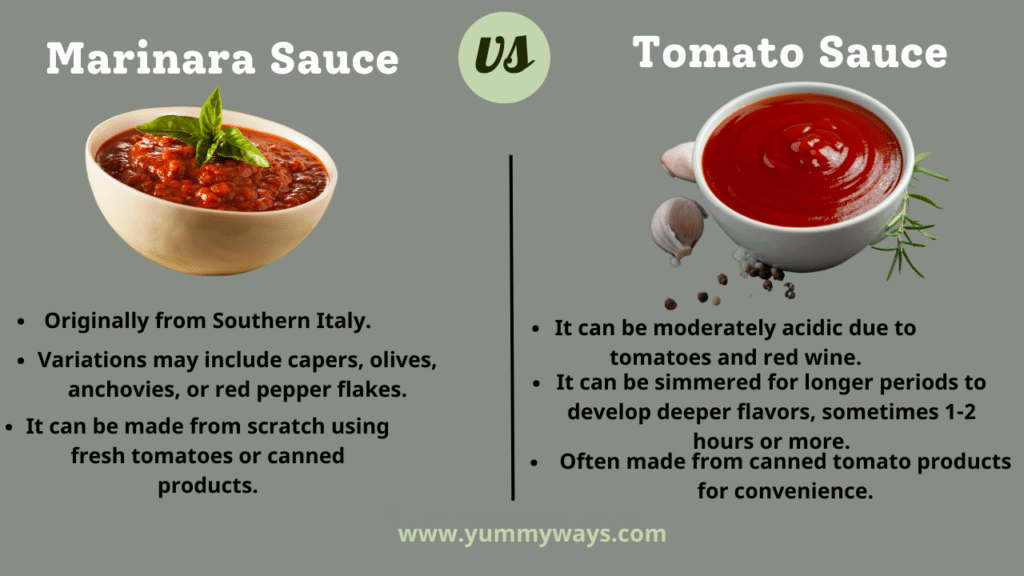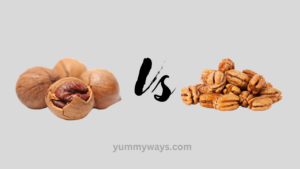Many people are confused about which is better, Marinara Sauce vs Tomato Sauce. Because these days, it is impossible not to eat sauce in various delicious dishes on various occasions. That’s why many people are interested to know which is tastier than Marinara Sauce vs Tomato Sauce, what is the difference between them, who is ahead regarding price, taste, advantages, and disadvantages, etc!
In today’s article, we will discuss Marinara Sauce vs Tomato Sauce in detail. So friends, if you are a marinara sauce lover, read the article, and if you are a tomato sauce lover, read the article and know the detailed information.

Also Read: Pasta vs Noodles: Which Should You Choose?
Contents
- 1 What is Marinara Sauce?
- 2 What is Tomato Sauce?
- 3 Overview of Marinara Sauce vs Tomato Sauce
- 4 Frequently Asked Questions
- 4.1 What is the difference between marinara sauce and tomato sauce?
- 4.2 Can I use marinara sauce instead of tomato sauce?
- 4.3 Can I make marinara sauce from tomato sauce?
- 4.4 Is marinara sauce gluten-free?
- 4.5 Can marinara sauce be frozen?
- 4.6 How long does marinara sauce last in the refrigerator?
- 4.7 Can I add meat to the marinara sauce?
- 4.8 Can I use dried herbs in marinara sauce?
- 4.9 Can I use marinara sauce as a pizza sauce?
- 4.10 What dishes can I make with marinara sauce?
- 4.11 Can I substitute marinara sauce for tomato sauce?
- 4.12 Do you use marinara or tomato sauce for spaghetti?
- 4.13 What is the difference between marinara sauce and regular spaghetti sauce?
- 4.14 Is marinara sauce sweeter than tomato sauce?
- 5 Also Read:
What is Marinara Sauce?
Marinara sauce is a classic Italian tomato sauce that is made from a few simple ingredients, including tomatoes, garlic, onions, olive oil, and various herbs and spices. It is known for its bright and fresh tomato flavour with a hint of garlic and herbs.
What is Tomato Sauce?
Tomato sauce is a condiment or cooking sauce made primarily from tomatoes, along with various other ingredients and seasonings. It is a versatile and widely used sauce in many cuisines around the world. Tomato sauce can vary in terms of its consistency, flavor, and intended use, and there are numerous regional and cultural variations of this sauce.
Overview of Marinara Sauce vs Tomato Sauce
| Feature | Marinara Sauce | Tomato Sauce |
|---|---|---|
| Ingredients | smoother and more uniform texture, although it can also be adjusted to be chunkier if desired. | Primarily consists of tomatoes, sometimes with added seasonings like garlic, onion, herbs, and salt. May vary in ingredients depending on the recipe. |
| Flavor | Bold and robust flavor with a balanced combination of tomatoes and herbs. Often has a slightly tangy or zesty taste. | Simpler, milder flavor focused mainly on the sweetness of tomatoes. The flavor can be more subtle without as many added herbs or seasonings. |
| Texture | Often used as a pasta sauce, pizza sauce, or base for various Italian dishes. | Typically thicker in consistency, with some texture from tomatoes and herbs. It can vary from chunky to smoother, depending on preparation. |
| Cooking Uses | Often used as a pasta sauce, pizza sauce, or as a base for various Italian dishes. | Versatile and used in a wide range of dishes, including pasta, soups, stews, casseroles, and as a base for other sauces. |
| Region of Origin | Originally from Southern Italy. | It can be moderately acidic due to tomatoes and red wine. |
| Acidity | Can be moderately acidic due to tomatoes and red wine. | It can be simmered for longer periods to develop deeper flavors, sometimes 1-2 hours or more. |
| Cooking Time | Variations may include capers, olives, anchovies, or red pepper flakes. | Can be simmered for longer periods to develop deeper flavors, sometimes 1-2 hours or more. |
| Variations | Variations may include ingredients like capers, olives, anchovies, or red pepper flakes. | It can be made fresh from scratch using fresh tomatoes or canned tomato products. |
| Common Dishes | Pasta dishes like spaghetti and lasagna, pizza, chicken Parmesan, and eggplant Parmesan. | Pasta dishes, soups (e.g., tomato soup), stews, chili, casseroles, and as a base for other sauces such as Bolognese. |
| Fresh vs. Canned | It can be made from scratch using fresh tomatoes or canned products. | Often made from canned tomato products for convenience. |
| Storage | Store in the refrigerator for a few days if homemade. Canned versions have a longer shelf life. | It can be made from scratch using fresh tomatoes or canned products. |
Also Read: Moo Goo Gai Pan vs Chicken With Mixed Vegetables: Whats the difference
Marinara Sauce vs Tomato Sauce
Regarding Italian cuisine, two popular and delicious tomato-based sauces often confuse people: marinara sauce and tomato sauce. While both have tomatoes as their main ingredient, there are some key differences between them. In this article, we will explore the characteristics, uses, and flavors of marinara sauce and tomato sauce so that you can choose the right one for your next culinary adventure.
Taste & Flavor
Marinara sauce and tomato sauce, while both tomato-based, exhibit distinct taste and flavor profiles. Marinara sauce boasts a vibrant, zesty essence with a prominent tomato presence. It’s enriched with garlic, onions, and herbs like basil and oregano, contributing to its robust, savory character. This results in a well-balanced, tangy flavor often associated with Italian cuisine, making it ideal for pasta dishes, pizzas, and as a dipping sauce.
Conversely, tomato sauce tends to be simpler, emphasizing the natural sweetness of tomatoes with minimal seasonings. It has a milder, smoother flavor, making it versatile for many recipes. Tomato sauce is a foundational element in many global cuisines, providing a neutral base for diverse culinary creations. Ultimately, the choice between marinara and tomato sauce depends on your desired taste and dish.
Marinara Sauce Recipe
Marinara sauce is a classic Italian tomato sauce that’s delicious and versatile. You can use it as a pasta sauce, pizza sauce, or base for many other Italian dishes. Here’s a basic marinara sauce recipe:
Ingredients
- 2 tablespoons olive oil
- 1 small onion, finely chopped
- 3-4 cloves garlic, minced
- 1 (28-ounce) can of crushed tomatoes
- 1 (14-ounce) can of diced tomatoes
- 1 teaspoon dried oregano
- 1 teaspoon dried basil
- 1/2 teaspoon red pepper flakes (adjust to your desired level of spiciness)
- Salt and black pepper to taste
- 1-2 teaspoons sugar (optional, to balance acidity)
- Fresh basil leaves, torn or chopped (for garnish, optional)
Instructions
- Heat the olive oil in a large saucepan over medium heat.
- Add the chopped onion and cook for about 3-4 minutes, or until it becomes translucent.
- Stir in the minced garlic and cook for another 30 seconds to 1 minute, being careful not to let it brown and become bitter.
- Add the crushed tomatoes, diced tomatoes, dried oregano, dried basil, red pepper flakes, salt, and black pepper to the saucepan. If your canned tomatoes are whole, you can break them up with a spoon as they cook.
- If your tomatoes are too acidic, add 1-2 teaspoons of sugar to balance the flavors. This is optional and depends on personal preference.
- Bring the sauce to a simmer, then reduce the heat to low, cover the saucepan, and let it simmer for about 20-30 minutes. Stir occasionally to prevent sticking and burning.
- Taste the sauce and adjust the seasoning as needed. You can add more salt, pepper, or herbs to taste.
- If you like a smoother sauce, use an immersion blender or transfer it to a blender and puree it until it reaches your desired consistency.
- Once the sauce is ready and has reached your desired thickness, remove it from the heat.
- Serve the marinara sauce over cooked pasta; use it as a pizza sauce or in your favorite Italian dishes. Garnish with fresh torn or chopped basil leaves if desired.
This basic marinara sauce is a great starting point, and you can customize it by adding other ingredients like sautéed mushrooms, olives, or capers for extra flavor. Enjoy!
Also Read: Kung Pao vs Szechuan: Exploring the Tastes, Textures and Culinary Traditions
Tomato Sauce Recipe
You can use this sauce as a base for pasta dishes and pizzas or as a condiment for various recipes.
Ingredients
- 28 ounces (800 grams) of canned crushed tomatoes or tomato puree
- 2 tablespoons olive oil
- 1 medium onion, finely chopped
- 3 cloves garlic, minced
- 1 teaspoon dried basil
- 1 teaspoon dried oregano
- 1/2 teaspoon dried thyme
- 1/2 teaspoon sugar (optional, to balance acidity)
- Salt and black pepper to taste
- Red pepper flakes (optional, for heat)
- Fresh basil leaves (optional, for garnish)
Instructions
- Sauté the Aromatics: Heat the olive oil in a large saucepan over medium heat. Add the finely chopped onion and cook for 2-3 minutes until it becomes translucent. Then, add the minced garlic and sauté for another 30 seconds to 1 minute until fragrant. Be careful not to burn the garlic, as it can become bitter.
- Add the Tomatoes: Pour in the crushed tomatoes or tomato puree and stir well to combine with the sautéed onions and garlic.
- Season: Add the dried basil, dried oregano, dried thyme, sugar (if using), salt, black pepper, and red pepper flakes (if you want some heat). Adjust the seasonings to your taste. Stir everything together.
- Simmer: Reduce the heat to low, cover the saucepan with a lid, and let the sauce simmer for about 20-30 minutes, stirring occasionally. This allows the flavors to meld and the sauce to thicken. If the sauce splatters while simmering, partially cover it with the lid.
- Check and Adjust: Taste the sauce and adjust the seasonings if needed. You can add more salt, pepper, or herbs according to your preference. If the sauce is too acidic, you can add a bit more sugar to balance the flavors.
- Serve: Once the sauce has reached your desired consistency and flavor, it’s ready to be used. You can use it immediately or let it cool and store it in an airtight container in the refrigerator for up to a week. You can also freeze it for longer storage.
- Garnish: Garnish your tomato sauce with fresh basil leaves before serving.
Final Comments
While marinara and tomato sauce are delicious tomato-based sauces, their preparation, flavor, and uses differ. Marinara sauce is a light and fresh sauce that is quick and easy to make, perfect for pasta dishes or as a dipping sauce. On the other hand, Tomato sauce is a more complex and bold sauce that requires longer cooking time, ideal for hearty dishes and braised recipes.
When deciding between marinara sauce and tomato sauce, consider the flavor profile you want to achieve and the dish you are preparing. Whether you prefer the bright and tangy taste of marinara sauce or the rich and hearty flavor of tomato sauce, both sauces will surely enhance your Italian culinary creations.
Also Read: Yakisoba vs Chow Mein: Unraveling the Battle of Asian Stir-Fried Noodles
Frequently Asked Questions
What is the difference between marinara sauce and tomato sauce?
Marinara sauce is a quick-cooking tomato sauce made with minimal ingredients like tomatoes, garlic, onions, and herbs. Tomato sauce is a more complex sauce that is cooked for a longer time and may contain additional ingredients like meats or vegetables.
Can I use marinara sauce instead of tomato sauce?
Yes, you can use marinara sauce as a substitute for tomato sauce in most recipes. However, keep in mind that marinara sauce has a slightly different flavor profile and might alter the taste of the dish.
Can I make marinara sauce from tomato sauce?
No, marinara sauce is a specific type of tomato sauce that is made from fresh tomatoes. Tomato sauce, on the other hand, can be made from fresh tomatoes or pre-made tomato products like canned tomato sauce.
Is marinara sauce gluten-free?
Yes, marinara sauce is generally gluten-free. However, it is always important to check the label of the specific brand you purchase to ensure it contains no gluten-containing ingredients.
Can marinara sauce be frozen?
Yes, you can freeze marinara sauce. Allow it to cool completely before transferring it to a freezer-safe container. It can be stored in the freezer for up to 3 months.
How long does marinara sauce last in the refrigerator?
Marinara sauce can be kept in the refrigerator for 4-5 days when stored in an airtight container.
Can I add meat to the marinara sauce?
You can add ground meat like beef, pork, or sausage to marinara sauce to make a meat sauce variation. Cook the meat separately before adding it to the sauce.
Can I use dried herbs in marinara sauce?
Yes, you can use dried herbs in marinara sauce. However, fresh herbs will provide a more vibrant flavor. If using dried herbs, use about half the amount specified for fresh herbs.
Can I use marinara sauce as a pizza sauce?
Yes, marinara sauce can be used as a pizza sauce. It is a classic choice for topping pizzas and provides a delicious base for various toppings.
What dishes can I make with marinara sauce?
Marinara sauce is versatile and can be used in various dishes like pasta, pizza, lasagna, and meatball subs and as a dipping sauce for breadsticks or mozzarella sticks.
Can I substitute marinara sauce for tomato sauce?
Yes, you can substitute marinara sauce for tomato sauce in most recipes, but be aware that marinara sauce contains additional ingredients like herbs and garlic, which may affect the flavor of your dish.
Do you use marinara or tomato sauce for spaghetti?
Marinara or tomato sauce can be used for spaghetti, depending on your preference.
What is the difference between marinara sauce and regular spaghetti sauce?
Marinara sauce is a specific type of tomato-based sauce that is simpler and contains fewer ingredients than regular spaghetti sauce. It is usually made with tomatoes, garlic, olive oil, and herbs like basil and oregano. On the other hand, regular spaghetti sauce can include a wider variety of ingredients, such as meat, vegetables, and additional seasonings, making it more complex in flavor and texture.
Is marinara sauce sweeter than tomato sauce?
No, marinara sauce is not sweeter than tomato sauce.

